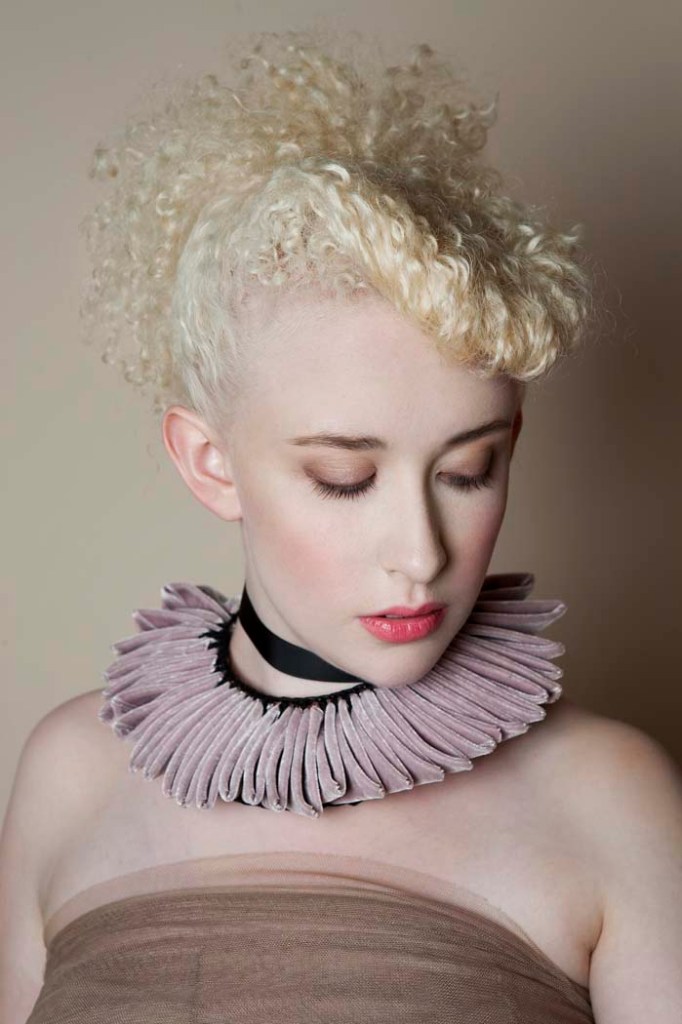Recycling waste into high fashion garments embodies what couture design has stood for: It “pushes the envelope,” challenges concepts of beauty and the role of clothing. It’s been about rebellion, symbolism, and a means of communication.
Making trash beautiful, extravagant, even risque, is the domain of the eco fashion designers featured in Sass Brown’s new book “Refashioned.” Prior to her October 15 FIT book launch, the author and assistant dean spoke about “recontexualizing” the discarded into a thing of lasting value and beauty.

Q. How is your current book “Refashioned” different from “ECO Fashion,” your previous book?
A. Markedly! My first book was about eco fashion writ large, a broad overview of different expressions of ecology and ethics in fashion design. This book is about designers working with recycled materials. It covers a broader range of fashion products, with more representation of accessories and jewelry designers.

Q. Why do eco designers need to be showcased in a book? Doesn’t it suggest that they’re a subset of fashion designers out there?
A. Eco design needs to be showcased, heralded and honored. There is cutting edge design being done, but there is not enough information about it. Many of the designers featured in the book are emerging independent designers. One purpose of the book is to give their work a greater audience.

There’s discussion about whether eco fashion should be separate from the mainstream industry. In truth, until the mainstream industry follows their lead on ethical and ecological business practices, they should shout about what they are doing, with the aim that these practices become so commonplace that they no longer require mentioning.

Q. How do you go from “trash to couture?” Isn’t garbage by definition stuff we’re supposed to permanently discard?
A. Therein lies the creative challenge. How do you recontextualize waste instead as resource? Orsola de Castro of From Somewhere tells a lovely story about visiting an Italian factory to pick up old stock sweaters to re-embellish and sell. She found instead all the wasted fabric offcuts from the cutting room floor, and so From Somewhere was born–a collection of almost entirely factory and mill wasted fabric. It’s a real life example of how one man’s trash is another’s treasure.

Q. The book is divided into pre- and post-waste streams, or the “once loved and unloved.” Why are these terms useful?
There’s a major difference between how pre- and post-consumer waste is collected and used. Pre-consumer waste by definition is unused waste produced through the production of stuff, like fabric left over from cutting out a garment. By definition, some of that waste is luxury waste.
Eva Zingoni is one designer working with leftover fabrics from luxury and couture houses in Paris. I’ve seen entire leather skins discarded with just a small piece cut out from the center, because that was the only part they wanted to use.
Post-consumer waste challenges are different. How do you go about collecting an individual’s waste? There isn’t a stable resource. Then you have to clean those discards. The greatest design challenge being how to redefine them into something entirely new! There are no single answers. That in part makes this area of design so rich, the multitude of responses to the design challenge.

Q. What type of designer’s work catches your eye? Is it the clever use of materials, or is purely based on aesthetics?
A. First and foremost sophisticated design. Whatever the materials being used, the end result must be beautiful. I don’t believe that there is any need for any more ugly and boring clothes in the world. It’s irrelevant how sustainable or organic they might be, if they have already been produced.

Q. Are there trends and styles to eco fashion, or is it all about imagination and design skills?
A. There will always be trends in fashion whether it’s expressed through ecological criteria or not. That said, there is a revaluing of good, timeless design as a matter of ethics–as opposed to fast-fashion trends.

Q. How do the restrictions to adhering to eco design standards enhance or challenge a designer’s creativity?
A. Working with waste materials constitutes a major design challenge. The designers I feature produce creative, sophisticated, intelligent designs because of the challenges that were posed. Imagine designing a collection where the color, texture and pattern of your materials are constantly changing, and so are their shape and size!
Q. Is eco fashion out to make more than a fashion statement?
A. Yes, we’re out to change the world! The impetus behind all ecological design is to make a difference to our world, in what we produce and how we produce it. All of which ultimately comes from an ecological concern for our planet.

Q. What are a couple examples of the surprising materials that are used in eco fashion? And when are even you surprised?
A. Steinwidder, an Austrian brand that produces a cool, rebellious collection of separates from used socks. Talk about a challenge in recontextualizing your materials! Mayer Peace Collection in Berlin fashions a military inspired collection from turn-of-the-century used flour sacks, and km/a, another Viennese label that produces a line of men’s and women’s coats and jackets from retired prison blankets.

These are materials with a story, heritage and authenticity that cannot be replicated. In a time when most people have lost all material connection to their clothing, the stories that come with these clothes are beyond value.

RSVP to attend the Sass Brown’s first book talk and signing in the Katie Murphy Amphitheater on October 15, 2013
Images used with permission